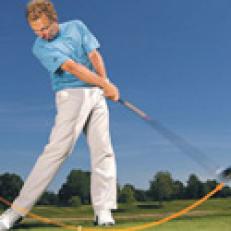Breaking 80
By
Jim Hardy with Matthew Rudy
Photos by
Darren Carroll
September 03, 2007
Understanding how the right arm moves in the downswing is a key to a successful one-plane motion. At the start of your downswing, keep your elbow up and to your side, but let the right forearm drop. This will keep your arms tight to your chest, and from there, you can fire your right hand at the ball, feeling the clubface close for a draw and stay open for a fade. The forearm drop was the heart of Ben Hogan's secret and the key to his becoming the best ball-striker ever.
In a one-plane swing, you're moving your arms around your torso. In a two-plane swing, your arms need to stay in front of your body. The way to visualize this is to imagine turning your shoulders while making a karate-chop move with your left arm.Practice hitting draws and fades with just your left hand, picturing the toe of your club closing and hitting the outside edge of the ball for a draw and remaining open and hitting the inside edge for a fade. The weight of the club will encourage the up-and-down movement you need.
In a two-plane swing, a player turns the shoulders on a fairly horizontal plane in the backswing and follow-through while actively moving the arms on a more up-and-down plane. Blending these two movements requires more timing but gives the added benefit of an extra power-generating lever. Classic two-planers include Jack Nicklaus, Tom Watson, Karrie Webb and Colin Montgomerie (pictured). Two-planers are often great long-iron players. They can hit it high and straight because of their steeper and narrower swing shape. Nicklaus was so great with long clubs because of his angle of attack and clubhead speed.














